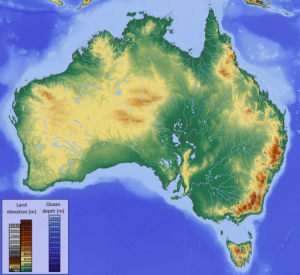
Credit: Hans Braxmeier via Wikimedia Commons.
Australia shifts and tilts back and forth by several millimeters each year because of changes to Earth’s center of mass, according to a new study. The findings could help scientists better track the precise location of Earth’s center of mass, which is important for GPS and other satellite measurements, according to the study’s author.
All bodies have a center of mass, or the average position of the mass of an object. Earth’s center of mass lies roughly at the center of the planet’s molten core, about 6,000 kilometers (about 3,700 miles) beneath the surface.
Seasonal changes to the distribution of water on Earth’s surface — largely through precipitation and evaporation — shift the planet’s center of mass a few millimeters in different directions.
The new study finds these movements cause Earth’s smallest continent to move back and forth with the seasons. Australia moves northwest by about 1 millimeter during its summer (winter in the Northern Hemisphere). At the same time, its northwestern edge tilts downwards by 2 to 3 millimeters, while the southeastern edge is lifted up by 2 to 3 millimeters. During its winter (summer in the Northern Hemisphere), the trend reverses, and the continent shifts southeast and reverses its tilt.
These changes are not enough to be felt by the country’s inhabitants but are enough to be detected by satellites.
“[Water] migrates every season,” said Shin-Chan Han, a professor of engineering at the University of Newcastle in Australia, and lead author of the new study published in the Journal of Geophysical Research: Solid Earth, a journal of the American Geophysical Union. “That motion causes quite a detectable, sizable deformation in Australia.”
Down under
Earth is roughly spherical, but the distribution of mass on its surface is not perfectly balanced. Water moves around the globe through precipitation and evaporation, and its average location depends largely on the seasons. At certain times, water accumulates more in some areas than in others, which causes slight changes to the planet’s center of mass.
When snowpacks in the Northern Hemisphere are at their peaks, the weight of water is strong enough to shift Earth’s center of mass a few millimeters closer to Europe. But six months later, when much of the rain and snow has returned to the atmosphere through evaporation, the center of mass moves closer to the south Pacific Ocean.
Han was looking to see if local changes in water near Australia might cause the continent to shift or move. The tectonic plate underneath Australia rests on a conveyor belt of molten rock called the asthenosphere. Convection in the asthenosphere moves each plate several centimeters every year, but the plates can also shift from other forces, including changes in where water is located.
To track Australia’s motion, Han measured changes in the locations of 14 land-based GPS stations across the continent. Although they orbit about 20,000 kilometers (12,500 miles) above Earth’s surface, GPS satellites can detect changes to land-based stations that are smaller than a millimeter.
Han then used data from the Gravity Recovery and Climate Experiment (GRACE), which uses two satellites to measure changes in the strength of gravitational pull over Earth, to measure the location of water.
By combining the new GPS and GRACE data, Han could measure how much the seasonal movement of water affected Australia. He found the continent shifts and tilts by several millimeters in response to the changes in water location far from Australia. These changes to water location affect Earth’s center of mass. All continents move slightly with the change in center of mass, but Australia experiences this more because it is directly in between Europe and the south Pacific Ocean, according to Han.
From Australia’s motion, Han was able to calculate the motion of Earth’s center of mass. The movement of the continent corresponded the movement of Earth’s center of mass. Although other methods can measure this movement, Han’s method is a secondary, independent check.
Han’s study shows GPS measurements across Australia are likely a millimeter or two off. While this may not amount to much of a difference on a day-to-day basis, it could be a concern for precision measurements, like those taken to determine sea level, he said.
“If our [GPS] station has some systematic distortion — deformation — it will impact our precise positioning calculation,” Han said. “So we need to know any systematic bias in our station to better understand our position.”
“This new way of determining the Earth’s [center of mass] … is a new and novel approach and will be taken up by others,” said Richard Gross, a researcher at NASA’s Jet Propulsion Laboratory in Pasadena, California, who was not involved with the new study. According to Gross, other scientists are likely to see if they can determine the motion of Earth’s center of mass using other continents besides Australia.
Reference:
Shin-Chan Han. Seasonal clockwise gyration and tilt of the Australian continent chasing the center of mass of the Earth’s system from GPS and GRACE. Journal of Geophysical Research: Solid Earth, 2016; DOI: 10.1002/2016JB013388
Note: The above post is reprinted from materials provided by American Geophysical Union.










